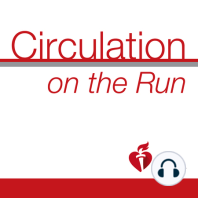17 min listen
Circulation April 27, 2021 Issue
ratings:
Length:
31 minutes
Released:
Apr 26, 2021
Format:
Podcast episode
Description
Dr Carolyn Lam: Welcome to Circulation on the Run! Your weekly podcast summary and backstage pass to the journal and its editors. We're your co-hosts, I'm Dr. Carolyn Lam, Associate Editor from the National Heart Center and Duke National University of Singapore. Dr. Greg Hundley: I'm Greg Hundley, Associate Editor, Director of the Pauley Heart Center, VCU Health in Richmond, Virginia. Dr Carolyn Lam: Greg, we got double features today. Now, the first one's all about fruit and vegetables. Now, before you switch off, this is a very important one, okay? So, listen on. And the second is on the EMBRACE heart failure trial. Now, this was a late breaker, very important, more data on empagliflozin, that SGLT2 inhibitor. So really, really fun discussions coming right up. But first, can I dig into one of the papers that I'm really dying to tell you about? Dr. Greg Hundley: Absolutely. Dr Carolyn Lam: Okay. This is all about the diagnostic performance of high-sensitivity cardiac troponin T strategies, that super hot topic. We know that European data support the use of low high sensitivity troponin measurements or a 0/1 hour algorithm for myocardial infarction or to exclude MACE among emergency department patients with possible acute coronary syndrome. However, there's really very modest U.S. data to validate these strategies. This study today from Dr. Allen and colleagues from University of Florida, really evaluated the diagnostic performance of an initial high sensitivity cardiac troponin T measure below the limit of quantification. And that is six nanograms per liter, a 0/1 hour algorithm, and their combination with heart scores for excluding MACE in a multi-site U.S. cohort. And this is the largest prospective multi-site U.S. study of high sensitivity troponin T strategies to date. Dr. Greg Hundley: Wow, Carolyn you've really piqued my interest. So what did they find? Dr Carolyn Lam: Okay. And initial high sensitivity, cardiac troponin T below that level of quantification of six nanograms per liter was associated with a negative predictive value of 98.3% for 30-day MACE. Okay. That was that value itself. Now the 0/1 hour algorithm rolled out 57.8% of patients with a negative predictive value of 97.2% for 30-day MACE. The addition of a low-risk heart score to that initial high sensitivity troponin T level below that six nanogram per liter and the 0/1 hour algorithm improved the negative predictive value for 30-day MACE to 99% and 98.4% respectively. Dr. Greg Hundley: Wow. Carolyn, it looks like a really comprehensive analysis of the high sensitivity troponin. So tell us what are the clinical implications of this study? Dr Carolyn Lam: So these data seem to imply that when used without a risk score and initial high sensitivity troponin T below six nanograms per liter, or a 0/1 one hour algorithm, may not have sufficient sensitivity or negative predictive value to exclude 30-day MACE in the U.S emergency department patients. But the addition of that low-risk heart score to those measures improves the negative predictive value, but rolls out fewer patients. And so in totality, these results suggest that in the U.S. Emergency departments, adding a risk score to either of these strategies really increases their safety. Dr. Greg Hundley: Boy, great new information in our journal. Well, Carolyn, I'm going to switch to the world of basic science and start to evaluate in this next paper, the regulation of cellular signatures in children with dilated cardiomyopathy, and the work comes to us from Dr. Stephanie Dimmeler from Goethe University in Frankfurt. So Carolyn, Stephanie's team performed single nuclei RNA sequencing with heart tissues from six children with dilated cardiomyopathy. One was age 0.5, 1.75 and another at 5, 6, 12, and then 13 years of age. And they did this to gain insight into age and disease-related pathophysiology, pathology, and molecular fingerprints. And the goal was to gain further insight into dilated cardiomyopathy, wh
Released:
Apr 26, 2021
Format:
Podcast episode
Titles in the series (100)
Circulation January 24, 2017 Issue: Circulation Weekly: Your Weekly Summary & Backstage Pass To The Journal by Circulation on the Run
